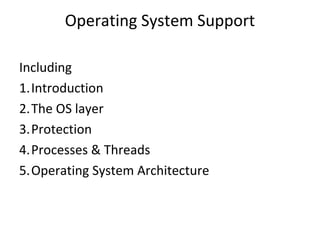2. microkernel new
•Descargar como PPT, PDF•
5 recomendaciones•3,041 vistas
Denunciar
Compartir
Denunciar
Compartir

Recomendados
Recomendados
Más contenido relacionado
La actualidad más candente
La actualidad más candente (20)
Introduction to Parallel and Distributed Computing

Introduction to Parallel and Distributed Computing
Similar a 2. microkernel new
Introduce F9 microkernel, new open source implementation built from scratch, which deploys modern kernel techniques, derived from L4 microkernel designs, to deep embedded devices.
:: https://github.com/f9micro
Characteristics of F9 microkernel
– Efficiency: performance + power consumption
– Security: memory protection + isolated execution
– Flexible development environmentF9: A Secure and Efficient Microkernel Built for Deeply Embedded Systems

F9: A Secure and Efficient Microkernel Built for Deeply Embedded SystemsNational Cheng Kung University
Similar a 2. microkernel new (20)
F9: A Secure and Efficient Microkernel Built for Deeply Embedded Systems

F9: A Secure and Efficient Microkernel Built for Deeply Embedded Systems
Más de AbDul ThaYyal
Más de AbDul ThaYyal (20)
2. microkernel new
- 1. Operating System Support Including 1.Introduction 2.The OS layer 3.Protection 4.Processes & Threads 5.Operating System Architecture
- 3. Definition of Kernel • The fundamental part of an operating system. • Responsible for providing secure access to the machine's hardware for various programs. • Responsible for deciding when and how long a program can use a certain hardware.
- 6. Hardware must provide at least two execution levels: • Kernel mode In this mode, the software has access to all the instructions and every piece of hardware. • User mode In this mode, the software is restricted and cannot execute some instructions, and is denied access to some hardware.
- 7. Types of Kernels 1. Monolithic Kernels 2. Micro kernels 3. Hybrid Kernels 4. NanoKernels 5. Exokernels
- 9. Monolithic Kernels • All OS services operate in kernel space • Good performance • Execute all of their code in the same address space (kernel space) • Rich and powerful hardware access • Monolithic Kernel : Kernel Image = (Kernel Core+Kernel Services). When system boots up entire services are loaded and resides in memory. • Example: Windows and Unix.
- 11. Disadvantages Disadvantages The dependencies between system components A bug in a driver might crash the entire system Large kernels → very difficult to maintain • E.g. Unix, Linux
- 13. Microkernels • Minimalist approach – IPC, virtual memory, thread scheduling • Put the rest into user space – Device drivers, networking, file system, user interface • Run most of their services in user space →improve maintainability and modularity • Micro kernel : Kernel Image = Kernel Core. Services are build into special modules which can be loaded and unloaded as per need.
- 14. Microkernel
- 15. • Disadvantages – Lot of system calls and context switches • E.g. Mach, L4, AmigaOS, K42
- 17. Operating System Architecture Monolithic Kernel Microkernel S4 Server: Dynamically loaded Kernel code and data: server program: 17 ....... ....... Key: S1 ....... S1 S2 S3 S2 S3 S4 Figure 5. Monolithic kernel and microkernel Couloris,Dollimore and Kindberg Distributed Systems: Concepts & Design Edn. 4 , Pearson Education 2005
- 20. Summary: Kernels • Monolithic kernels – Advantages: performance – Disadvantages: difficult to debug and maintain • Microkernels – Advantages: more reliable and secure – Disadvantages: more overhead • Hybrid Kernels – Advantages: benefits of monolithic and microkernels – Disadvantages: same as monolithic kernels • Nano kernel & Exo kernels – Advantages: minimal and simple – Disadvantages: more work for application developers
- 21. Thank You
